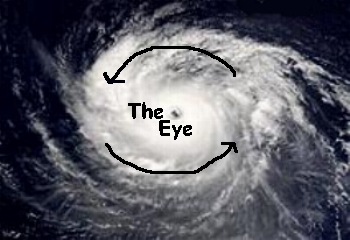Weather Wiz Kids weather information for kids

LEARN EVERYTHING ABOUT HURRICANES
Hurricanes are the most powerful weather systems on Earth, though they are known by different names in different regions. In the Western Pacific, for example, you will hear hurricanes referred to as "cyclones." Hurricane season in the Atlantic, the time when hurricanes are most apt to form, runs from June 1 until November 30.
Formation: Most hurricanes that eventually make it to the southern United States get their start as tropical waves off the west coast of Africa. The warm waters there give rise to clusters of thunderstorms that move over miles of warm ocean currents. As the winds in these storms move in colliding directions, they form a circulation over an area of low pressure. The condensation of water vapor "feeds" the storm, which continues to grow in strength as long as it is over warm water or warm, moist air.
Stages of development: These vertical systems that develop over the ocean are categorized by their wind speeds. Once its winds reach a maximum of 38 miles per hour (mph), a system is labeled a tropical disturbance or tropical depression. In any given hurricane season, only about 10 percent of these depressions make it to the next stage, tropical storm. When its winds reach 39 mph, the system becomes a tropical storm and is given a name.
Tropical storms are capable of property damage and flooding. In June 2001, Tropical Storm Allison hit the city of Houston, Texas, dropping 37 inches of rain in five days.
If a tropical storm's winds reach or exceed 74 mph, the system officially becomes a hurricane. The hurricane is a well-organized storm with a well-defined eye, capable of mild to extensive damage.
Intensity: Hurricanes are categorized primarily by their wind speeds. Storm surge and minimum surface pressure are also contributing factors. Meteorologists use the Saffir-Simpson Scale, a 1 to 5 rating system, to estimate the potential damage of a hurricane, with a Category 5 being the strongest and deadliest storm.
Who's at risk? The Eastern United States is most vulnerable to hurricanes, along the coast from Maine to Texas. Of the 10 tropical storms on average that develop in the North Atlantic each year, two are likely to have an impact on the U.S. Hawaii is also at risk from tropical storms that develop in the Pacific Ocean. If you live in an area that is at risk, you should have a plan in place if evacuation becomes necessary, and you should know your evacuation routes. Hurricanes are serious, dangerous storms, but there's usually enough advance warning to take action to protect yourself, your family, and your property.
WATCH A VIDEO ABOUT THE HURRICANE KATRINA 2005

LEARN EVERYTHING ABOUT HURRICANES
Hurricanes are the most powerful weather systems on Earth, though they are known by different names in different regions. In the Western Pacific, for example, you will hear hurricanes referred to as "cyclones." Hurricane season in the Atlantic, the time when hurricanes are most apt to form, runs from June 1 until November 30.
Formation: Most hurricanes that eventually make it to the southern United States get their start as tropical waves off the west coast of Africa. The warm waters there give rise to clusters of thunderstorms that move over miles of warm ocean currents. As the winds in these storms move in colliding directions, they form a circulation over an area of low pressure. The condensation of water vapor "feeds" the storm, which continues to grow in strength as long as it is over warm water or warm, moist air.
Stages of development: These vertical systems that develop over the ocean are categorized by their wind speeds. Once its winds reach a maximum of 38 miles per hour (mph), a system is labeled a tropical disturbance or tropical depression. In any given hurricane season, only about 10 percent of these depressions make it to the next stage, tropical storm. When its winds reach 39 mph, the system becomes a tropical storm and is given a name.
Tropical storms are capable of property damage and flooding. In June 2001, Tropical Storm Allison hit the city of Houston, Texas, dropping 37 inches of rain in five days.
If a tropical storm's winds reach or exceed 74 mph, the system officially becomes a hurricane. The hurricane is a well-organized storm with a well-defined eye, capable of mild to extensive damage.
Intensity: Hurricanes are categorized primarily by their wind speeds. Storm surge and minimum surface pressure are also contributing factors. Meteorologists use the Saffir-Simpson Scale, a 1 to 5 rating system, to estimate the potential damage of a hurricane, with a Category 5 being the strongest and deadliest storm.
Who's at risk? The Eastern United States is most vulnerable to hurricanes, along the coast from Maine to Texas. Of the 10 tropical storms on average that develop in the North Atlantic each year, two are likely to have an impact on the U.S. Hawaii is also at risk from tropical storms that develop in the Pacific Ocean. If you live in an area that is at risk, you should have a plan in place if evacuation becomes necessary, and you should know your evacuation routes. Hurricanes are serious, dangerous storms, but there's usually enough advance warning to take action to protect yourself, your family, and your property.
Δεν υπάρχουν σχόλια:
Δημοσίευση σχολίου